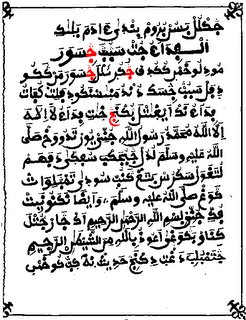Showing posts with label Wolof. Show all posts
Showing posts with label Wolof. Show all posts
Monday, January 11, 2010
Ajami in Boston
The Boston Globe has an article today about Ajami, the tradition of transcribing African languages in the Arabic script. It focuses particularly on the efforts of Fallou Ngom, whose work has been mainly on Wolof Ajami in Senegal, the subject of one of my first posts here. In the article he emphasises the potential historical significance of such work in opening up neglected sources on African history. While most African manuscripts are in Arabic, some historically rather interesting Ajami sources are known; for Mandinka, published historical manuscripts include the Pakao Book and the Bijini manuscript, the latter outlining regional history over the past 500 years. There are undoubtedly more out there that have gone uninvestigated simply for lack of enough historians who can read them. My work on Ajami has focused more on issues of orthography, however: most African languages have rather different sound systems to Arabic, and it's quite interesting to see what kind of devices they developed to make the alphabet fit better.
Tuesday, June 21, 2005
Writing Wolof (or rather وَلَفْ)

With apologies for the long hiatus in my postings, I would like to present another topic in West African writing: the surprisingly formalized tradition of writing Wolof, the main language of Senegal, in Arabic script. Wolof is also written in Latin script, I should note, which you can see copious examples of in the pedagogical materials on this Gambian Peace Corps site, but the Arabic script is much more widely known, especially in rural areas, although French is far more widely used for writing than Wolof in any script.
Myself, I only went to Dakar, so books in Wolof of any sort were relatively hard to come by. However, Arabic bookstalls, while rarer than the French ones, weren't hard to find (they had a predominantly religious focus, but a number of literary, scientific, and historical works), and, while most of their works were in Arabic, they had a couple of Wolof religious texts in a rather nice Arabic script, of which I enclose a scan. I was going to retype some, but even a cursory effort revealed serious issues. For instance, there is a Unicode letter for the common West African vowel sign that indicates short e (a dot under the letter, smaller than dots that form part of the letter) - the charts say it's 065C - but I can't find a font that will display it; and another common letter which seems to indicate ny or nj, jiim (ج) with three extra dots on top, isn't in Unicode at all. Apart from those, the main differences with standard Arabic seem to be:
- Short e is as described previously; long e is indicated by adding an alif maqsura ى with a small alif on top (another character I can't seem to find fonts for, despite its commonness in the Qur'an; it should be 0654.)
- p is a ba ب with three dots on top (and actually is in Unicode - 0751.)
- A dal with three dots above (ڎ) occurs some places; I don't know how it's pronounced.
- gaaf is a kaaf with three dots (ڭ), following longstanding Maghrebi tradition.
- Again in the Maghrebi tradition, faa has its dot below, and qaaf has a single dot above.
PS: You can find a font that will display some of these letters at PakType; however, their selection is more adapted for Sindhi (which has the largest Arabic-based alphabet I know of) than for West Africa.
PPS: Apparently, the latest version of PakType can display all these after all; see comments...
Subscribe to:
Posts (Atom)